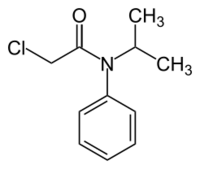Chemistry:Propachlor

| |
| Names | |
|---|---|
| Preferred IUPAC name
2-Chloro-N-phenyl-N-(propan-2-yl)acetamide | |
| Other names
2-Chloro-N-isopropylacetanilide
| |
| Identifiers | |
3D model (JSmol)
|
|
| ChEMBL | |
| ChemSpider | |
PubChem CID
|
|
| UNII | |
| |
| |
| Properties | |
| C11H14ClNO | |
| Molar mass | 211.69 g·mol−1 |
| Appearance | light tan solid |
| Density | 1.139 g/mL |
Except where otherwise noted, data are given for materials in their standard state (at 25 °C [77 °F], 100 kPa). | |
| Infobox references | |
Propachlor (2-chloro-N-isopropylacetanilide)[1] is an herbicide first marketed by Monsanto. It was registered for use in the United States during 1965.[2]
The preparation acts on annual grasses and on some broadleaf weeds [1] and was briefly sold in the UK as a germination inhibitor under the name Murphy Covershield.
Between 1987 and 1996, about 2.1 million pounds of its active ingredient were used in the United States.[3] 75% was applied to sorghum crops and 24% to maize.[3]
Monsanto voluntarily discontinued its manufacture in 1998.[4] It is currently listed in the U.S. Environmental Protection Agency's Toxics Release Inventory.[5] In 2008, the European Commission issued a decision withdrawing its approval for use as of March 18, 2009, citing the presence of its metabolites in groundwater.[6] Propachlor was added to California 's Proposition 65 list as a carcinogen in 2001.[7]
Current manufacturers
It is currently being produced by Makhteshim Agan Group and Shenzhen Qinfeng Pesticides Co., Ltd.[8]
References
- ↑ 1.0 1.1 Warholic, DT; Gutenmann, WH; Lisk, DJ (1983). "Propachlor herbicide residue studies in cabbage using modified analytical procedure". Bulletin of Environmental Contamination and Toxicology 31 (5): 585–7. doi:10.1007/bf01605479. PMID 6640157.
- ↑ "Propachlor (Ramrod, Bexton) Herbicide Profile 2/85". Cornell University. http://pmep.cce.cornell.edu/profiles/herb-growthreg/naa-rimsulfuron/propachlor/propach_prf_0285.html. Retrieved 2009-09-09.
- ↑ 3.0 3.1 "Reregistration Eligibility Decision (RED) - Propachlor". U.S. Environmental Protection Agency. http://www.epa.gov/oppsrrd1/REDs/0177red.pdf. Retrieved 2009-09-09.
- ↑ "Illinois Pesticide Review". University of Illinois Extension Service. http://web.extension.uiuc.edu/ipr/i4189_829.html. Retrieved 2009-09-09.
- ↑ "Toxics Release Inventory (TRI) Chemicals in TOXMAP". http://toxmap.nlm.nih.gov/toxmap/main/chemicals.jsp. Retrieved 2009-09-09.
- ↑ "COMMISSION DECISION of 18 September 2008 concerning the non-inclusion of propachlor in Annex I to Council Directive 91/414/EEC and the withdrawal of authorisations for plant protection products containing that substance". European Commission. http://eur-lex.europa.eu/LexUriServ/LexUriServ.do?uri=OJ:L:2008:251:0039:0040:EN:PDF. Retrieved 2009-09-09.
- ↑ "CHEMICALS KNOWN TO THE STATE TO CAUSE CANCER OR REPRODUCTIVE TOXICITY AUGUST 7, 2009". State of California Environmental Protection Agency. http://www.oehha.ca.gov/prop65/prop65_list/files/P65single080709.pdf. Retrieved 2009-09-09.
- ↑ Farm Chemicals International (2012-03-12). "Propachlor". http://www.farmchemicalsinternational.com/cropprotection/cpd/?op=cpdproductdetail&pid=323760. Retrieved 2012-06-27.
External links
- Propachlor in the Pesticide Properties DataBase (PPDB)
 |

